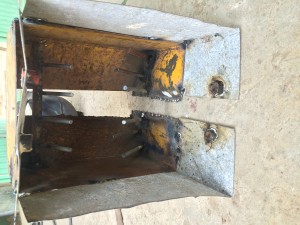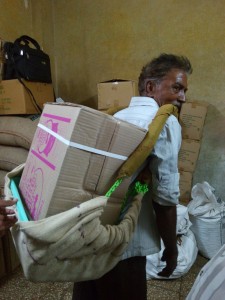1. Developing solutions to Improve efficiency and ergonomics of coconut leaves broom makers – Yash Goyal, Pranav Kaushal, Gunjit Thapar University, Patiala
 The problems we have identified are in the process of broom making using coconut leaves. These stalks are hand stripped from the coconut tree leaves. For improving efficiency and ergonomics of the process, some of the solutions are proposed. Most of broom makers including men, women and children in Jamalpur area of Ahmedabad, perform repetitive ta
The problems we have identified are in the process of broom making using coconut leaves. These stalks are hand stripped from the coconut tree leaves. For improving efficiency and ergonomics of the process, some of the solutions are proposed. Most of broom makers including men, women and children in Jamalpur area of Ahmedabad, perform repetitive ta
sks which might result in physical and musculoskeletal issues. The current techniques and methods practiced have little or no safety considerations and hence stress the need for either proper safety equipment, or a new method to make these brooms, which does not compromise on efficiency and also reduces safety concerns. Keeping these problems in mind, as well as understanding the economic background of the broom makers, our team members came up with various ideas, which were mapped, and detailed, at the same time modified or rejected on the basis of the feedback given by various mentors and professors. After scrutinizing and detailing, two designs have been finalized, which have been further explained.
The first field visits, were aimed to observe each process involved in making a broom, and understanding what part of each process was posing a problems to the broom makers. We identified the practice of tying the metal wire using the hands as a major problem, as it resulted in a number of cuts and burns on the palm, in fact the extent of these cuts was such that the palms would become completely numb after a few months and the people doing this could actually not feel their palms. Another problem was tying of a colored ribbon, which was tied by rotating the broom by pressing it with the feet and tying the ribbon. This led to pain in the legs. Also, every process like trimming was done on an unstable piece of log and thus was a potential hazard.
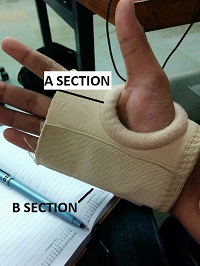 After noting down and mapping the problems, our team discussed various designs which could be refined into possible solutions, and mapped the same. Various ideas were also discarded after various mentors and professors citied safety concerns during the use of these designs. Finally, we converged to the idea of designing a workspace which would address all concerns and at the same time also design a safety glove for the specific process of tying the metal wire to the broom, as this was identified as the main problem by our team. The design of the machine is inspired from the traditional foot operated sewing machine, and design consists of a stand, where the stalks of the broom can be strapped and this stand will be rotated allowing the broom maker to just hold the metal wire to the broom in order to tie it. The ribbon can also be tied to the broom in the same way. The glove is intended to work as a safety equipment and will contain metallic strips in two sections (marked section A and B in the figure) to ensure that the metal wire, does not affect the hands of the user and at the same time does not tear the fabric of the glove, thereby increasing it life and effectiveness. The material is polyester with foam padding. The designing of the glove involved another field visit to ensure that the concerns and opinion of the broom makers was also taken into account, and after this field visit, the design of the glove was modified.
After noting down and mapping the problems, our team discussed various designs which could be refined into possible solutions, and mapped the same. Various ideas were also discarded after various mentors and professors citied safety concerns during the use of these designs. Finally, we converged to the idea of designing a workspace which would address all concerns and at the same time also design a safety glove for the specific process of tying the metal wire to the broom, as this was identified as the main problem by our team. The design of the machine is inspired from the traditional foot operated sewing machine, and design consists of a stand, where the stalks of the broom can be strapped and this stand will be rotated allowing the broom maker to just hold the metal wire to the broom in order to tie it. The ribbon can also be tied to the broom in the same way. The glove is intended to work as a safety equipment and will contain metallic strips in two sections (marked section A and B in the figure) to ensure that the metal wire, does not affect the hands of the user and at the same time does not tear the fabric of the glove, thereby increasing it life and effectiveness. The material is polyester with foam padding. The designing of the glove involved another field visit to ensure that the concerns and opinion of the broom makers was also taken into account, and after this field visit, the design of the glove was modified.
Prototypes of both designs are currently being developed and will then be taken for user testing and feedback.
2. Device for improving the efficiency of labors in cotton picking- Banala Bhargava Reddy (Sri Aurobindo College, Delhi University), Rakesh Choudhary (NIT-Hamirpur), Ravi Sonkriya (IIT-Delhi)
Cotton is extensively grown in India. The growing of cotton includes several steps like sowing seeds, irrigating, picking & selling. Cotton picking is done mostly by hands in India primarily by women. One of our group member has personally experienced this problem as his parents are in farming. The main problem occurs in picking stage due to repetitive motion of hands, standing posture in hot conditions throughout the day. There are machines available in the market to harvest the cotton however these machines are not suitable for Indian context especially the type of cotton grown in dryland cotton. This report includes propose solutions aiming at improving the efficiency of the workers and reducing the drudgery.
The solutions are proposed after brainstorming & flow charting of individual ideas (see fig a-b). Human ergonomics, affordability and other functional aspects are kept in mind.
Our ideas were presented to Nathubhai Vader an innovator and farmer in Erwada village. Some are basically the same mechanism used in Nathubhai Cotton Picking machine instead the idea is to make it hand driven. The rotators will be fixed on the side of a cart and it is driven in between the lanes of the cotton.
The next day we have visited his workshop and discussed further on our ideas. He has demonstrated a model of cotton plant and illustrated the mechanism on which our model works & how the device should work. The cotton picking machine of Nathubhai was in the workshop so we have studied the whole process of that machine step by step. We gathered some material required for the prototype in the workshop
itself. We got a box made of iron. We fabricated it according to our design. Our design is at initial model stage and we are working on a prototype of our model (see fig a-c).
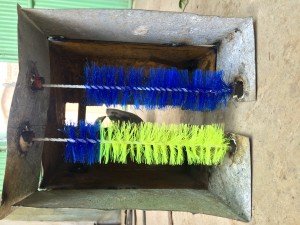

3. Design of a foldable vending cart for mobile vendors- Parth Patel, IET, AU, Pranjal Srivastava, Thapar University, Patiala
 Keeping in mind the current scenario of the space crunch that is prevalent in all the major cities of India, especially the metropolitans; there is a serious need of urban equity to be implemented for the mutual harmony of all the stakeholders in the
Keeping in mind the current scenario of the space crunch that is prevalent in all the major cities of India, especially the metropolitans; there is a serious need of urban equity to be implemented for the mutual harmony of all the stakeholders in the
current system. In the daily life of a common vendor, the cart (lari) is an indispensable part of his/her life. It is used for showcasing the goods of a vendor and as a storage place, sometimes doubling up as a place for resting/sleeping. The problems identified in the current cart are: the absence of a proper handle design to hold the cart for maneuvering; absence of any braking system or steering mechanism; the proper storage of carts when not in use, which is the problem we decided to work upon.
After a hard day’s work, the vendors are faced with a limited number of choices;
1. To either park the cart in lodging and pay rent
2. To leave the cart on the side of the road, which is then in probable danger of being impounded by the policemen, for which they have to pay a fine to free the cart
3. To take the cart to their homes where it causes a decrement in the already minimal space
In all three scenarios, the cart is left unused and occupies space which if optimized, can be used more efficiently. This led us to design a cart which when not being used, can be restructured so that its components align in such a fashion that it occupies less space. This feature helps in more no. of carts to be fitted in a limited space and efficient storage of the cart.
The new design draws its analogy from the folding chairs and folding tables and their mechanism. However, the frame of the cart should not deform under heavy load (250-300 kg.) and should maintain stability during turning. The material of the cart should be of adequate stiffness and strength to bear the pressure. The current prototype tries to incorporate all these factors into its design.


(a-Folded) Frame of the current prototype (b-open)
4. A simple fulcrum based device to eliminate child labor an increase safety in spray cans dismantling- Vaibhav Gupta- IIT Delhi, AkhilSoni- IIT Delhi, NishantHooda- CCET Chandigarh.
The problem that our group identified when we visited gyaspur slum was of removing plastic knobs from spray cans by dumpers who collect garbage and then dump off at the dumping site.
 Based on the observations and discussion with the people it was observed that they get hand injuries while they dismantle the cans using stones. Also, there is a high possibility of health impacts due to constant exposure to the gases emerging out when the knob separates. Even children were involved in this process, so there is an involvement of child labor as well and eliminating it, are our responsibility.
Based on the observations and discussion with the people it was observed that they get hand injuries while they dismantle the cans using stones. Also, there is a high possibility of health impacts due to constant exposure to the gases emerging out when the knob separates. Even children were involved in this process, so there is an involvement of child labor as well and eliminating it, are our responsibility.
There was ample amount of brain storming involved. We studied the entire process starting from the collection of cans till the final dismantling of it. We targeted the area where child labor was involved and narrowed down our problem. Further, we started to design our product based on all the suggestions and observations. We proposed three designs and on the various suggestions and feedback’s given by the mentors and the innovators, we finalized on a single idea.
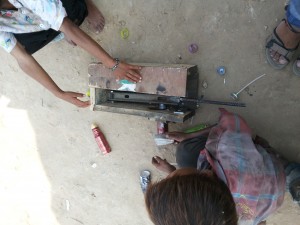 A fulcrum based device which hammers the cans and the plastic knob separates off. This idea is based on the observations of how the people did this process using the rocks. It is based on the same principle which they apply when they use stones. There is a circular cavity where the can head goes in and then like a slaughter hammer, the user rams down the hammer on the can head. In this way, the can heads get hammered and narrow down in turn leading to the removal of the plastic knob.
A fulcrum based device which hammers the cans and the plastic knob separates off. This idea is based on the observations of how the people did this process using the rocks. It is based on the same principle which they apply when they use stones. There is a circular cavity where the can head goes in and then like a slaughter hammer, the user rams down the hammer on the can head. In this way, the can heads get hammered and narrow down in turn leading to the removal of the plastic knob.
Finally, when we completed our prototype we went to the users to take their feedback. They have suggested various changes in the model and we will incorporate it in our product within the next few days.
5. Designing a device for providing safety and/or increasing efficiency while purifying and ploughing clay for making pots- PrajalGoyal, IIT Delhi
 The project involved understanding the process of making pots by small manufacturers and the problems they face in the whole process. Observations at the field were made to understand the process of making pots, people involved in the process and the supply of pots to the market. Analysing the whole process of pottery in detail, problems were mapped and two major problems were narrowed down. One is the problem of injuries during the purification of clay and other is the excessive pollution caused during baking of the pots in the kiln. Since, there has been no significant variation in the methods used for purifying soil from years and this is process is dangerous as well as time consuming, this problem was chosen to further work on.
The project involved understanding the process of making pots by small manufacturers and the problems they face in the whole process. Observations at the field were made to understand the process of making pots, people involved in the process and the supply of pots to the market. Analysing the whole process of pottery in detail, problems were mapped and two major problems were narrowed down. One is the problem of injuries during the purification of clay and other is the excessive pollution caused during baking of the pots in the kiln. Since, there has been no significant variation in the methods used for purifying soil from years and this is process is dangerous as well as time consuming, this problem was chosen to further work on.
After understanding the problems, some probable solutions to these would be manually operated mixer, shoes with nails and electric mixer (see fig a-b).

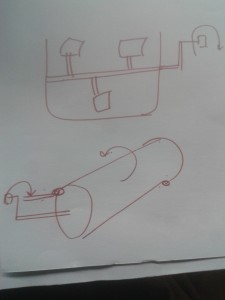 A container or drum shaped device can be designed with cutters inside to mix soil and water. Another solution could be shoes with nails at the bottom to solve the purpose. These solutions would remove the possibilities of injuries and/or make the process faster.
A container or drum shaped device can be designed with cutters inside to mix soil and water. Another solution could be shoes with nails at the bottom to solve the purpose. These solutions would remove the possibilities of injuries and/or make the process faster.
These solutions were shown to the users for their feedback on our designs. Manually operated mixer required much effort and space as said by them. Some of them had already tried this solution and found not suitable for working. The problem with shoes was that the shoes would get stuck in the mud making the task even more difficult. Electrically operated mixers are already there in the market but not used by small households there because money and space is an issue.
6. Improving the ergonomics and safety of the workers carrying load on their back- Gaurav Kumar- National Institute of Technology Agartala, PrajalGoyal- Indian Institute of Technology Delhi, Priya Singh- National Institute of Technology Goa
The purpose of this process is to design a technique for load carrying by sack bag reducing the pain and improving the efficiency of the process. Workers which include both men and women, carrying load face health problems including joint pain and lower back pain due to heavy load upto 90 kgs with only a hook for support. Therefore, the process followed was to understand the process in detail, the workers involved, other market factors and then to get to probable solutions to help them (see fig a).
The idea was to use a cross body support with a net design to carry the load which would be easier to load and unload the filled up sack bag. Moving on, the prototype was made using an old sack bag which was stitched and a nylon rope handle was attached. Later to reduce the pain foam was stitched at the handles. This first model was tested at Suresh bhai’s storage at Kalupur market area. After the user feedback, we added a plastic basket tray at the bottom and also stitched a plastic sack at the back for support and to avoid the bag from falling. This improved model was then tested with two users, Umesh and Prajal for a 30 kg sack bag and 20 kg carton box. From the feedback from the user and the mentors, we need to improve the prototype with a suitable base frame material, height of the back support and broader surface area at the shoulder part of the handle (see fig b-c). The feedback chart has to be checked for a sample size of 35 with the improved model.
7. Designing a brick carrying device for improving ergonomics and efficiency of laborers at construction sites- Krunal Dave – Vishwakarma College, Ahmedabad, Vishal Chitara – Indian Institute of Technology Delhi, Nikhil Gehlot – SRM University, Ghaziabad
Carrying bricks on head is the most common practice adopted by the laborers at construction sites in India and the other developing countries. Most of these laborers are women especially in India. Carrying bricks/load on head might cause injuries in brain and neck, pain in muscles and other spinal problems. Bricks on back using a rope, on shoulders using wooden plank, etc. are few others ways of doing the task of transporting bricks on construction sites. However, these solutions may not be safe and comfortable, though they increase the efficiency. Wheel barrows and pulleys are also used at large construction sites but at small scale the brick carrying is done by laborers. There are many prototypes/devices are available which are not in use or well accepted by the laborers. The main reason behind this could be no interest of contractors and other stakeholders due to the cost, efficiency and durability of previous solutions. The other reason could be the laborers did not find these devices useful and comfortable.
On interaction with professors and innovators and taking all aspects into account, the following prototype can be a low cost, durable, comfortable, light weight and efficient solution (see fig a-b).
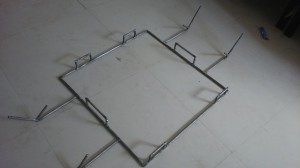
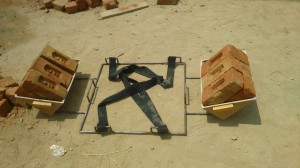
The prototype is basically a square frame of 10mm TMT bars (24”x24”) with 2 stands for wooden boxes, handles for support. The side attachments are nylon belts, wooden boxes for brick carrying. Except nylon belts, these materials are usually available on construction sites. The capacity of loading of this device is around 12 bricks (4.5”) at one time. The wooden boxes are detachable and can be used for other purposes during construction.
In users’ feedback, some problems with the device are identified. The problem faced by laborers in unloading and the large size of frame which causes improper balancing while handling the device. Reducing the size of frame can be a solution for this problem.
8. To Increase the productivity of date-palm leaves broom makers- Rohit Hari – Product Design, MIT Institute of Design
 These broom makers come to Ahmedabad from Chittorgarh, Rajasthan just to make and sell brooms here in the city. They make brooms by beating on nails. This process is extremely tiring and takes at least 5 minutes to beat one broom. This process is very important as it creates fibers of the broom. The tool they use for beating is called a ‘cheena . As you have to hold the broom in your hand and beat it, it is very painful after some time. The main action which happens in this process is ‘beating and pulling’ of the broom. This action has to be repeated at least 15-20 times after which the broom is then ready to be finished and then sold off.
These broom makers come to Ahmedabad from Chittorgarh, Rajasthan just to make and sell brooms here in the city. They make brooms by beating on nails. This process is extremely tiring and takes at least 5 minutes to beat one broom. This process is very important as it creates fibers of the broom. The tool they use for beating is called a ‘cheena . As you have to hold the broom in your hand and beat it, it is very painful after some time. The main action which happens in this process is ‘beating and pulling’ of the broom. This action has to be repeated at least 15-20 times after which the broom is then ready to be finished and then sold off. 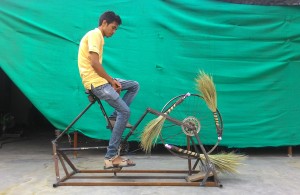
They make almost 50-60 brooms per day and each broom costs around 20 rupees. If we increase their productivity, it will definitely benefit from it and at least have 2 proper meals every day. And they can go back to their native place and stay in proper houses.
So I wanted to make a machine for them which would be cheap, easily repairable and that would be ergonomic and at the same time increase productivity. Right now they make 1 broom in 5 minutes, but by using this machine they can make 6 brooms in 5 minutes (some modifications needed).

